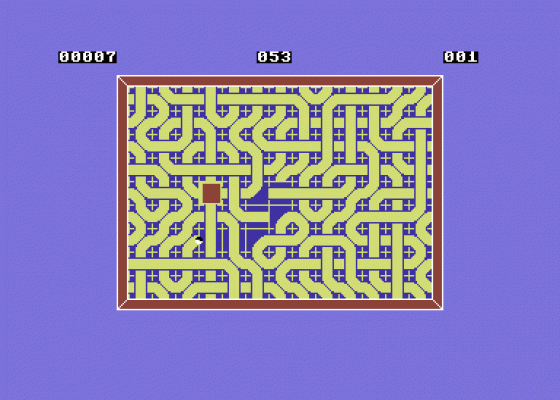
C&VG
 1st January 1988
1st January 1988
Categories: Review: Software
Publisher: Diamond
Machine: Commodore 64
Published in Computer & Video Games #75
Diablo
Robtek's software arm, Diamond Games has been guilty in the past of releasing sub-standard product such as their abysmal chess program Checkmate.
This time they have come up with an original and enjoyable little game that will appeal to many of the puzzlers amongst you.
Diablo is based on the old mosaic puzzle, which consists of a matrix of jumbled up tiles, each with a portion of a pattern or picture. The pattern can be restored by sliding the tiles either vertically or horizontally.

In Diablo, the matrix is made up of 119 tiles, each containing two pieces of track. At the start of the game, a ball appears at the top of the screen, and starts rolling along the track.
Each time the ball rolls from one tile to the next, the track on the tile it has just left, disappears.
So, as the game progresses, there will be some tiles still with two bits of track, others with one, and some will have been travelled over twice and will thus be "clean".

The aim of the game is to guide the ball over every piece of track, thus cleaning every tile on the screen. The problem is that not every piece of track links to another piece on an adjacent tile and, for the first part of each level, you must also stop the ball from rolling off the edge of the screen.
To do this you can manipulate tiles, just as in the original puzzle, by sliding them into the "tileless" square on the screen.
When you can see there is a long stretch of "joined up" track ahead, you can make the ball roll faster to save time, although it is all too easy to suddenly discover the ball has got nowhere to go with little or no time to do anything about it.
With plenty of screens, and a random track generator thrown in for good measure, Diablo should keep ST owners amused for long enough to justify the £14.95 price tag. But at £19.95 the Amiga version is not such good value. It's a lesson companies are going to have to learn if the Amiga is really going to take off as it should do. Let VFM by the lesson. That's Value For Money.
Scores
Commodore 64 Version| Graphics | 70% |
| Sound | 70% |
| Value For Money | 70% |
| Playability | 70% |
| Overall | 70% |
Scores
Atari ST Version| Graphics | 70% |
| Sound | 70% |
| Value For Money | 70% |
| Playability | 70% |
| Overall | 70% |
Scores
Amiga 500 Version| Graphics | 70% |
| Sound | 70% |
| Value For Money | 70% |
| Playability | 70% |
| Overall | 70% |







